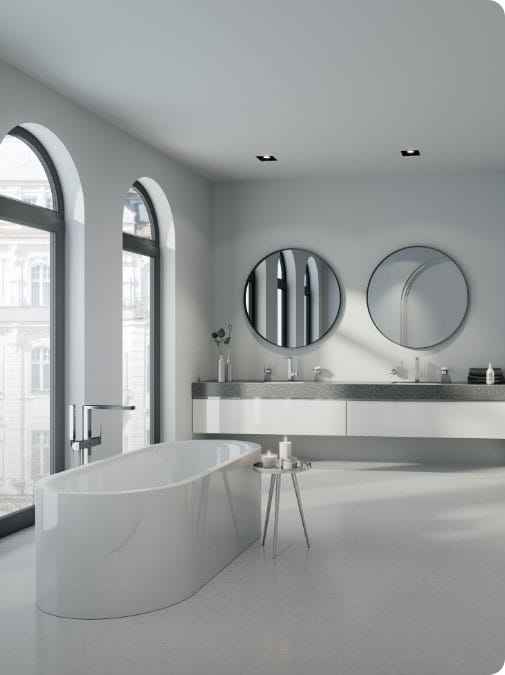Fact Sheet: 3D Printed Faucets from DXV by American Standard
Jun 4, 2015
Video: 3D Printing and the Future for Interior Design
What makes the new DXV faucet designs unique?Additive manufacturing opens up new possibilities for the design and function of faucets, enabling new ways to present water and completely reinventing the user’s experience.
- Two of the new faucets are focused on reinventing the way that water is brought to the user. The incredibly high strength of the alloy enables fine structures of concealed waterways that converge at the top, shortly before reaching the aerator. This construction creates the impression that water appears magically out of the faucet.
- One design is an eye-catching mesh of delicate latticework, while the second faucet has the waterways separated into four thin sections, giving it a more traditional appearance.
- With the third faucet, the focus was on designing the experience of water. The water is presented to the user as a stream bouncing on rocks in a riverbed. To achieve this poetic effect, the design team used Computational Fluid Dynamic (CFD) technology to adjust each of the 19 waterways to achieve the proper effect. The rest of the faucet is extremely pure and simple, not to distract from the play of the water.
How do you “print” a faucet?
There are different types of 3D printing. The process for printing the DXV faucets is called selective laser sintering:
- A computer-guided laser beam fuses, or sinters, powdered metal into the shape of the faucet with high heat and pressure.
- A solid metal block arises out of powder, hinting at the sculpted masterpiece-to-be.
- The block requires hand-finishing to smooth extraneous metal and reveal the faucet design.
- The actual printing—the laser sintering—takes about 24 hours.
- It is not all about the printing. The DXV faucets go through a butler finishing process for a hand-polished look and feel that mimics the texture found on silver pieces after years of being hand buffed and polished.
Haven’t there already been 3D printed faucets?
3D printing has been used to create plastic faucet models and concepts for years, using another 3D printing process called fused deposition modeling. It’s the additive manufacturing process most people are familiar with, layering plastic in rows to build an item. American Standard and others have used fused deposition modeling in faucet design concepting for years.
The DXV faucets are the first ready-for-market working residential faucets to be printed in metal.
Where can I buy one of the new DXV 3D Printed Faucets?
These new DXV faucets will be available through an exclusive network of showrooms, likely within the next 12 months or so. The estimated retail price will be somewhere between $12,000 - $20,000.
Do they meet US code approvals?
All three DXV faucets have received NSF certification. Inconel does not contain any lead, so we easily passed all low-lead code approvals.
These 3D bath faucets meet the stringent high performance and water efficiency standards for WaterSense®-certification from the U.S. Environmental Protection Agency (EPA). They use 32 percent less water than standard bathroom faucet models.
How will 3D printing impact the design and construction Industry?
3D printing will have a major disruptive effect on the design and construction industry, and DXV by American Standard is the first plumbing manufacturer to introduce a residential product for commercialization.
The process democratizes design and decentralizes manufacturing, which will eventually upend the design and construction industry, along with many others. A new, more efficient business model for bespoke design could be on the horizon. This would reduce the inventory pressures that arise from mass production of personalized products, while opening up a new world for both design and construction.
For more information, contact PR counsel Nora DePalma at 770.772.4726 or at nora.depalma@oreilly-depalma.com.
WaterSense® is a registered trademark of the U.S. Environmental Protection Agency (EPA).


